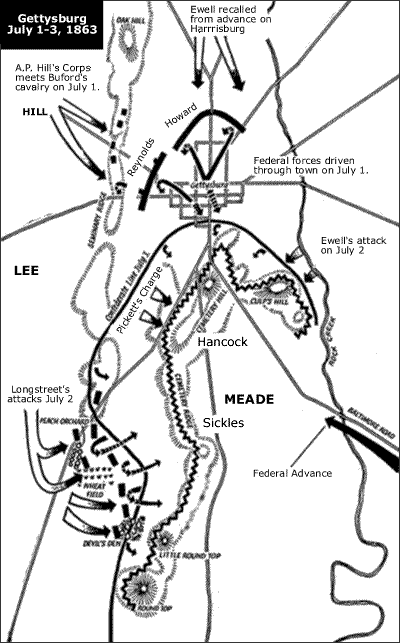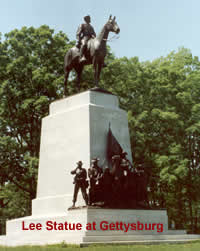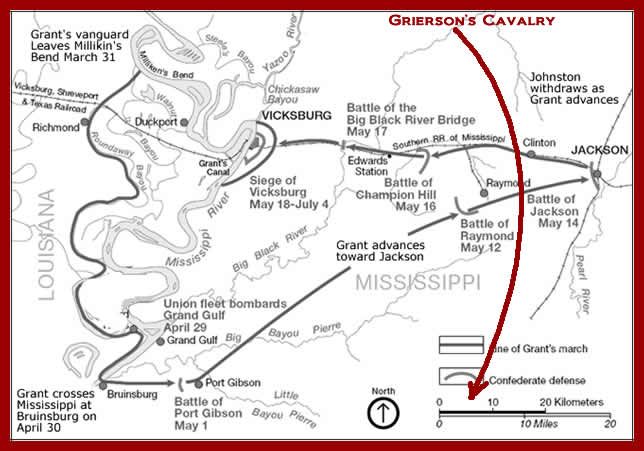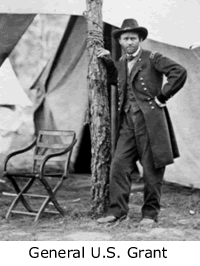Gettysburg & Vicksburg
Gettysburg: The Second Turning Point.
The Battle: Day 1, July 1, 1863
The Battle of Gettysburg occurred more or less by accident. Neither General Lee nor General Meade, who took command only a few days before the battle, had planned to fight there. General Ewell, now commanding Jackson’s corps, was headed toward Harrisburg, but some of Lee’s troops commanded by A.P. Hill, always on the lookout for a source of shoes and other provisions, sent a detachment toward Gettysburg, where a dozen roads crisscrossed the landscape and a railroad was under construction. Not knowing exactly where the Federals were—ever since Stuart had departed days earlier, Lee had been without his eyes and ears—Lee did not know that the Union 1st Corps under General John Reynolds was approaching Gettysburg from the southeast direction.
Union cavalry in the capable hands of General Buford was reconnoitering southern Pennsylvania in advance of the Union Army, which was making its way along the Baltimore Turnpike, and on the morning of July 1 was just passing through Gettysburg. Buford discovered a division of Hill’s Corps under the command of Henry Heth just west of the town and sent word back to Reynolds. Meanwhile, Buford decided to take Heth’s men under attack. Heavily outnumbered, Buford sent word back to Reynolds, urging him to hurry.

Reynolds's 1st Corps and Hill’s Corps clashed on the northwestern outskirts of the village, while General Ewell was called from his advance towards Harrisburg to join the action at Gettysburg. The arrival of Union General Oliver O. Howard’s 11th Corps helped to shift the balance toward the Union, which for much of the day was outnumbered. (Confederate Corps were larger than those of the Union.) The Union men were driven back through the town of Gettysburg and onto some high ground to the south and east of the town—Culp’s Hill and Cemetery Ridge. That's where the fighting ended the first day. At least for the time being Lee seemed to have the upper hand.
Day 2: July 2
Neither General Lee nor General Meade had been present when the fighting began on the first day at Gettysburg. Lee was drawn to the action by the sounds of fire from Heth’s division and quickly sent officers forward to determine what was going on. Not having contemplated a full engagement while his army was still divided, Lee nevertheless realized the he was too heavily engaged to break off the action, so he urged his remaining divisions forward. By the end of the day he had established himself on Seminary Ridge, a strip of high ground backed by woods on the southwest side of the town of Gettysburg. General Ewell’s corps, which had joined the action during the first day, was deployed around to the northeast side of Gettysburg facing Culp's Hill, part of the II Corps was arrayed along the northernmost segment of Seminary Ridge, and that component of Longstreet's Corps which was already on the battlefield was south of Hill's men. (See Map)
General Meade had arrived late in the evening of the first day of fighting and called his officers together in to assess the situation. With parts of his army and supplies advancing along the Baltimore Pike from the southeast direction, Meade understood that defending his position on Culp’s Hill was crucial. By the next morning General Slocum’s XII Corps was entrenched on Culp's Hill, with Howard's XI Corps on his left flank and Winfield Scott Hancock’s II Corps extending to the South along Cemetery Ridge. On Hancock’s left Flank was Daniel Sickles’ III Corps.
Having been successful with a double envelopment at Chancellorsville, Lee decided to again attack the flanks of the Union Army. But Gettysburg was a different place, and leadership in the Union army had been shaken up in the month since that last battle, and perhaps more important, Stonewall Jackson was no longer Lee’s top lieutenant. Lee's instructions to General Ewell were to take Culp’s Hill “if practicable,” the sort of command Jackson would have taken as leaving no room for doubt. Ewell threatened the Culp's Hill position, coming within yards of the Union supply train, but he never broke through.
On the south end of the battlefield, General Longstreet was directed to advance on the left flank of the Union line on the southern portion of Cemetery Ridge. A crucial piece of ground, Little Round Top, was unoccupied for most of the day, but Longstreet felt that a move around to the rear of the Union line behind Round Top and Little Round Top would be more effective. The details of the fighting on the second day are readily available from multiple sources. Suffice it to say that neither Ewell nor Longstreet accomplished what General Lee had in mind. Most critically for the outcome of the battle, a union officer had discovered that Little Round Top was uncovered, and quickly dispatched Union troops to that high ground to protect it. The famous 20th Maine regiment under Colonel Joshua Chamberlain held off attacks from three Alabama regiments, and at the end of the day the Union line stretched from Culp's hill to Little Round Top, with its seven corps arrayed the famous fishhook formation. The three Corps of Lee's army were arrayed from the northwest facing Culp’s Hill to the South along Seminary Ridge facing the Union line across a mile or so of open ground.
The Third Day: July 3
The third day of Gettysburg was the turning point of the war in the East. Jeb Stuart had arrived late in the evening of the second day, pleased to report that he had captured a train of union supplies, but General Lee was not impressed: Union supplies were of little use to him at that point. Because the inevitable confrontation between Lee and Stuart took place in private, it is not known exactly what was said. What is known is that Lee, despite the feelings of some of his generals that Stuart should be court-martialed, knew that his bold cavalry commander was too valuable to lose.
Perhaps realizing that so far he had committed much and gained little in this campaign, and that not only his army but the remaining southern forces were beginning to run out of resources, Lee decided to gamble on one great, bold stroke. He would attack directly into the center of the Union line, using George Pickett’s fresh division, which had not been engaged in the second day, supported by additional troops from Ewell’s corps. General Meade, a thoughtful if not in brilliant general, concluded that Lee, having tried the flanks unsuccessfully, would attack the center. With Winfield Scott Hancock’s II Corps in the center of the Union line, Meade was confident.
Shortly after noon on July 3rd General Lee’s artillery opened up a furious barrage designed to weaken the Union defenses along Cemetery Ridge. Thus began the greatest artillery duel ever conducted in the Western Hemisphere. It is reported that as the wind shifted during the afternoon, the rumbling of the cannon could be heard as far away as both Pittsburgh and Philadelphia. Whether that is true or not, the smoke, fire and noise that erupted were never forgotten by the troops present that day. Because of the smoke raised, it was difficult for the gunners to determine the effectiveness of their artillery fire upon the enemy. Thus Lee’s artillerymen were unaware that much of their shot was passing over the Union lines and landing in the rear, where it did considerable damage to supplies and other rear echelon elements, but had little impact on the troops who were preparing to defend against the assault. Union artillery, meanwhile, ceased firing to replace round shot with canister, turning their artillery pieces into what might be called overgrown shotguns in anticipation of the infantry charge.
 When the smoke finally cleared General Pickett’s division, some 15,000 strong, marched out of the woods to the music of regimental bands, with bayonets glistening, and arrayed themselves in an impressive line stretching along the front edge of Seminary Ridge. Union troops on Cemetery Hill were awed by the spectacle, but, still smarting from Fredericksburg and Chancellorsville, they were not intimidated. Union artillery, stocked with canister, moved their guns into position to fire directly into the advancing troops.
When the smoke finally cleared General Pickett’s division, some 15,000 strong, marched out of the woods to the music of regimental bands, with bayonets glistening, and arrayed themselves in an impressive line stretching along the front edge of Seminary Ridge. Union troops on Cemetery Hill were awed by the spectacle, but, still smarting from Fredericksburg and Chancellorsville, they were not intimidated. Union artillery, stocked with canister, moved their guns into position to fire directly into the advancing troops.
The objective of Pickett’s men was a copse of trees, still very prominent on the Gettysburg battlefield to this day. As his troops began to march, converging on that objective, they passed through a relatively low area, across a road and a wooden fence and then advanced up the slope toward the Union lines. When they were within range, Union riflemen and artillery let loose a furious volley of shot that tore great holes in the Confederate line. Nevertheless, the courageous southern soldiers pressed forward until a small group of them, perhaps a few hundred, reached a stone wall at the front of the Union line. Scrambling over the wall, they engaged the Yankees hand-to-hand, using rifle butts, bayonets, fists—anything that might bring an enemy down—in a few minutes of furious combat. But the damage had been too great, and the Confederate soldiers inside the Union lines who were not killed or wounded were soon captured, and the remnants of Pickett's division stumbled back toward Seminary Ridge. It is reported that General Lee rode out on his horse and confronted General Pickett, feeling that his division commander should try to organize an orderly retreat. “General Pickett,” he is supposed to have said, “you must see to your division.” The shattered General Pickett replied, “General Lee, I have no division.”
Thus ended three days of fighting that produced over 50,000 casualties on both sides. There was no fighting on July 4; both sides needed to recover. Lee began a painful evacuation back to Virginia with wagon trains of wounded soldiers moaning in their pain. President Lincoln, feeling that another opportunity had been lost to crush Lee's army once and for all, wrote an angry note to General Meade deploring the fact that he had let Lee escape. Rather than sending the note, however, the president held it and later concluded, “How can I criticize a man who has done so much for doing too little?”
There was no more major fighting in eastern sector in 1863. The destiny of the South was still being played out in Tennessee.
Vicksburg: The Decisive Turning Point

The City of Vicksburg occupies a steep bluff overlooking the Mississippi River. In 1863 the city was well fortified by state-of-the-art fortifications and heavy cannon. Sometimes known as fortress Vicksburg, the city stood across the Mississippi from the terminus of a railroad line that brought Texas beef and other supplies as well as military equipment smuggled into Texas from Mexico, where the ports were not affected by the American blockade. Another railroad lined left Vicksburg and stretched through Jackson, Mississippi, and back to the Eastern theater. The Vicksburg fortifications kept the Mississippi essentially closed to Union traffic north and south of the city.
The Vicksburg garrison numbered about 35,000 men under the command of General John C. Pemberton, a Pennsylvanian who was married to a woman from Virginia. To the north of the city stand Chickasaw bluffs, a steep, wooded approach that could be accessed only by going through the messy Chickasaw Bayou. To the south are more steep cliffs, also well protected. Approaching the city from the river side would have been well nigh impossible.
Starting in the fall of 1862 Grant began trying various strategies to capture Vicksburg. From his base in Memphis grant set out to approach Vicksburg by an inland route through a supply base which he established at Holly Springs in northern Mississippi. But cavalry raids by Nathan Bedford Forrest and Earl Van Dorn repeatedly disrupted Grant’s supply lines and he was forced to withdraw. Grant then tried sending gunboats and transports through to the swamps and bayous on both sides of the Mississippi, but often found the waterways thick with overhanging branches and channeled through swampy ground. Progress was slow, and Confederate sharpshooters could easily harass attempts to cut a path through the natural barriers. In early 1863 Grant even had General Sherman’s men try to reroute the Mississippi though “Grant’s canal,” a ditch across a neck of land in a bend in the Mississippi opposite Vicksburg. None of those approaches worked, and Grant knew he had to find a way to get at the fortress city from the eastern land side.
 The result was what Civil War historians have accurately called the most brilliant campaign of the Civil War. Grant had Flag Officer Foote float his gunboats and transports down the Mississippi without power during the dark night; most of them made it. Then Grant marched his entire army South along the west bank of the Mississippi past Vicksburg, crossed the river at Bruinsburg, and set out for Jackson, about 40 miles to the east of Vicksburg. Grant commandeered all the wagons he could find and took his supplies with him, cutting off communication with the river (and with Washington) as he headed northeast.
The result was what Civil War historians have accurately called the most brilliant campaign of the Civil War. Grant had Flag Officer Foote float his gunboats and transports down the Mississippi without power during the dark night; most of them made it. Then Grant marched his entire army South along the west bank of the Mississippi past Vicksburg, crossed the river at Bruinsburg, and set out for Jackson, about 40 miles to the east of Vicksburg. Grant commandeered all the wagons he could find and took his supplies with him, cutting off communication with the river (and with Washington) as he headed northeast.
Meanwhile Grant directed cavalry officer Colonel Benjamin Grierson to take a cavalry force from Holly Springs through the area around Jackson and down to Baton Rouge. Grierson led three regiments of cavalry, about 1,700 troops, 600 miles in a little over two weeks. They tore up railroad tracks, cut telegraph wires, destroyed bridges, warehouses and railroad equipment and generally raised hell, occasionally making feints to distract Confederate pursuers.
Grant fought his way to Jackson, rolling over outnumbered defenders, as Pemberton could not relieve the entire Vicksburg garrison. Securing his rear at Jackson, Grant then turned toward Vicksburg’s defenders, who had come out to meet him. After winning a battle at Champion’s Hill, he drove the Confederates relentlessly back into the city. His attempts to storm the garrison, however, failed, and Grant settled into a siege which lasted 45 days. When Pemberton found his men, as well as the inhabitants of the city, desperately short of supplies and under constant bombardment from Grant’s artillery, he had no choice but to surrender. Pemberton turned over the city and its garrison on July 4, 1963, one day after Lee’s troops were turned back in Pickett’s charge at Gettysburg.
President Lincoln, who had grown up in the Mississippi Valley and understood the significance of the capture of Vicksburg, sent a telegram of congratulations to Grant. He is said to have remarked, “Once again the father of waters flows unvexed to the sea.” The double blow of Gettysburg and Vicksburg crippled the South and set the stage for the final phase of the war.
The New York City Draft Riots. Despite the victories at Vicksburg and Gettysburg President Lincoln could not rest easy throughout the summer and fall of 1863. The combination of the Emancipation Proclamation and the draft system, which placed the burden of the continued fighting mostly on working-class men who could not afford a substitute, led to discontent, especially among the Irish working-class people in New York City. Fearing that liberated slaves might threaten their economic well-being, and disgruntled over the implications of the draft, workers fomented a riot in New York City to show their discontent with the war and emancipation.
Rampaging through black neighborhoods they set fires and beat or terrorized African-Americans. Eleven men were murdered by lynch mobs, and the riots were only quelled when federal troops were sent from Pennsylvania to the city. Although the naval bombardment depicted in the recent film Gangs of New York did not occur, federal troops used artillery against the rioters, who numbered in the thousands.
The Copperheads. Lincoln’s problems did not end with the suppression of the New York race riot. Political opposition to Lincoln's wartime policies were headed by a group of disgruntled Democrats, called copperheads by their Republican opponents. Although members of the movement did not have a unified agenda, they were opposed to the war, and many of them thought it was being fought to free the slaves and destroy the South. Some of the same motives that propelled the New York rioters were present among the copperheads, who were politically very active.
The most famous copperhead was Clement L. Vallandigham, an Ohio politician who made speeches openly critical of Lincoln and his policies. Accused of disloyalty in time of war, Vallandigham was court-martialed, convicted and eventually given free passage through Confederate lines and made his way to Canada, from where he ran for governor of Ohio. He was defeated in a pro-war landslide, but his Democratic supporters managed to get a copperhead platform accepted during the 1864 presidential election. The Democratic nominee, George B. McClellan, did not accept the copperhead agenda and was pro-war, though Lincoln feared the ultimate result if McClellan were elected.
Chickamauga. In September 1863 the battleground shifted to southeast Tennessee and northwestern Georgia. General Longstreet, whose Corps had been detached from Lee's army, joined forces with General Bragg and attacked Union forces south of Chattanooga along Chickamauga Creek. The Union army was spared a disastrous defeat by the bravery of General George H. Thomas and his brigade, who stood their ground long enough to allow the Union Army to make an orderly retreat into Chattanooga. For his performance Thomas became known as the “Rock of Chickamauga,” and his brave soldiers the Chickamauga brigade. A statue of General Thomas is located on the circle bearing his name in Washington, DC.
As the Federal troops in Chattanooga suffered from supply shortages and poor morale, General Grant was directed to proceed to Chattanooga to take charge. Grant arrived inauspiciously, purchased a horse from a local stable, and rode out to the Union headquarters. Calling the commanders together, he asked each to outline for him the disposition and condition of his troops. He sat listening quietly and when he had heard enough, he began writing out orders for each commander on a notepad. Distributing the written instructions, he told his officers that they had their orders and sent them on their way. Within a few days supply lines had been opened and troop morale began to return.
Chattanooga. In November 1863 the last major battle of that decisive year was fought at Chattanooga. Grant’s corps commanders, Generals Hooker, Sherman and Thomas, engaged Bragg’s troops while Longstreet was carrying out a siege of Knoxville. Once again a corps commander, General Hooker took his men to the heights of Lookout Mountain which overlooks the city of Chattanooga and the Tennessee Valley. In an action that became known as the “battle above the clouds,” Hooker drove the Confederates off the mountain and raised the national flag at the summit, encouraging the troops below.
Although Grant had ordered that there be no frontal assaults against well-defended Confederate positions, troops under Sherman and Thomas approaching Confederate defenses along Missionary Ridge took it upon themselves to assaults the Confederate lines, feeling that they were vulnerable in the position they held at the base of the ridge. The assault was successful, and the battle resulted in Chattanooga, the “gateway to the South,” being fully in Union hands. One of the two major Confederate armies still in operation had been routed.
Summary of 1863. The three great Union victories at Gettysburg, Vicksburg, and Chattanooga shifted the tide dramatically in favor of the Union, but the South was not yet defeated nor ready to surrender; soldiers on both sides prepared for another year of warfare. President Lincoln weathered political storms but was concerned about his reelection if the war had not been settled by then.
1864
As the third full year of fighting dawned, questions abounded. Grant had captured two Confederate armies numbering over 40,000 men, and Lee's Army of Northern Virginia had suffered huge casualties, not only at Antietam and Gettysburg but also in their victorious engagements. If the outcome of the Civil War was inevitable, one might ask, how was the South able to carry on in the face of such losses? At the same time one might ask how the men of the Union, and their women at home, remained willing to accept such sacrifice in the face of an enemy that seem determined to continue the slaughter at all costs.
In his classic history of the Army of the Potomac, historian Bruce Catton, discussing the reasons why thousands of veterans whose three-year enlistments had expired in the early 1864 were willing to sign up for further service wrote that, “the dominant motive, finally, seems to have been a simple desire to see the job through.” The same sort of motivation drove Confederates to continue the struggle in the face of difficult odds: both sides had invested an enormous amount of blood and treasure in the conflict, and it was difficult to cast aside such a costly investment and give up the fight. So the fight went on.
President Lincoln, finally realizing that he had found a general who might be able to finish what others had started, brought Grant east to take command of all the Union armies and awarded him the rank of lieutenant general, the first officer since George Washington to have been given that honor. Although Grant was warmly received in Washington, he did not take well to the political environment of the city and quickly made his way to the Army of the Potomac headquarters where he conferred with General Meade, who officially remained the Army’s commanding general. Grant returned to Washington for conferences, but when he returned two weeks later the Army of the Potomac was for all practical purposes now Grant’s army. Waiting to take the measure of their new opponent were Robert E. Lee and the Army of Northern Virginia. The war was about to enter its final stage.
As commander of all Union forces, Grant was now able to devise a strategy that would take advantage of the North superior numbers and the South’s dwindling resources. General William T. Sherman had taken over command of the army of the Tennessee and was prepared to move into Georgia. Grant’s strategy was to have his Army of the Potomac capture Richmond while Sherman captured Atlanta, then the two armies would execute a pincer movement on Lee’s army in Virginia. Grant assigned additional missions to other officers, Generals Butler and Sigel, but the focus of the final year of fighting was on Grant and Sherman.
| Civil War Home | Civil War Introduction | Background 1850s | Civil War 1860-1862 |
| Decisive Year 1863 | Civil War 1864-1865 | Turning Points | Updated June 20, 2017 |